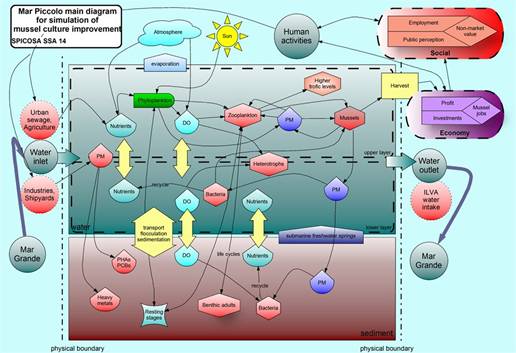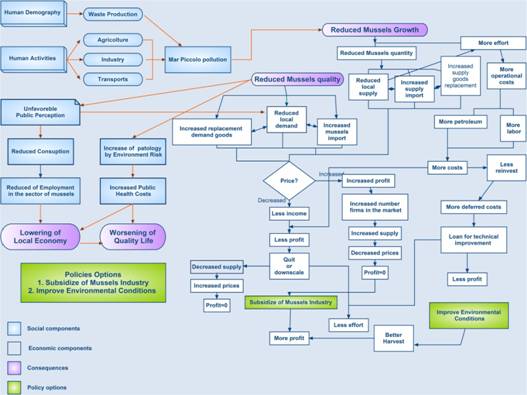Construct conceptual models of the CZ systems response to the Policy Issue(s) that will allow visualization of its primary characteristics.
Subtask Description:
Construct conceptual models of the CZ systems response to the Policy Issue(s) that will allow visualization of its primary characteristics.
Action points of the implementation:
- Sketch diagrams showing relationships amongst system components, and system boundary exchanges, for the parts of the ‘natural ecosystem’ that are relevant to the Issue and thus which need to appear in the ‘virtual system’.
Area:
Mar Piccolo, Taranto, Italy.
Policy Issue:
Sustainable use of the Mar Piccolo resources in order to include mussel culture.
Human Activities:
Industrial and urban activities, maritime transport, tourism, agriculture, clam fishing.
General Information:
One of the most important economic activities in the lagoon is fishing of clams, accounting for 60% of national production. The actual sustainability of the sector is at the moment uncertain: over-fishing, ‘fishing down the food-web’, sediment re-suspension, damage to benthos and habitat destructions are some of the recurrent problems. These days the fishery activity is allowed only within restricted lagoon areas the management of which is given to fishermen cooperatives in order to preserve their productivity by encouraging the fishermen to take care of the water basins assigned to them. Still, there are social problems related to the competition for the seed from natural nurseries, and the competition for the more productive water basins. The main stakeholder concerns are connected to social conflicts, the profitability risks, the quality of the product and the environmental status of the system.
Example of Implementation:

Figure 1: ESE Conceptual Model (click for full sized version).

Figure 2: Socio-Economic Conceptual Model (click for full sized version)
Comments:
In this example the first conceptual model is centralised to the natural system although it is incorporating the linkages to the socio-economic system. The second conceptual is devoted to the analytical representation of the system. The conceptual models of the integrated system can be more than one and it is likely that they change form during the process.
Contact:
Carmela Caroppo, Carmela.Caroppo@iamc.cnr.it
![[Logo] : Coastal-SAF.eu](/images/logo.png)